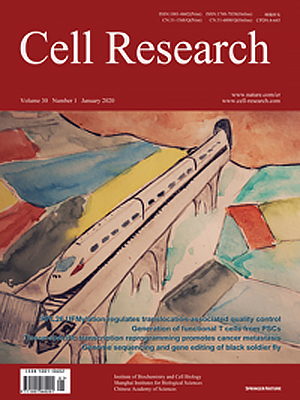
Volume 30, No 1, Jan 2020
ISSN: 1001-0602
EISSN: 1748-7838 2018
impact factor 17.848*
(Clarivate Analytics, 2019)
Volume 30 Issue 1, January 2020: 88-90 | Open Access
LETTERS TO THE EDITOR
Crystal structure of heliorhodopsin 48C12
Yang Lu1, X. Edward Zhou2, Xiang Gao2, Na Wang1, Ruixue Xia1,
Zhenmei Xu1, Yu Leng1, Yuying Shi3, Guangfu Wang3,Karsten Melcher 2, H. Eric Xu 2,4 and Yuanzheng He 1
1Laboratory of Receptor Structure and Signaling, HIT Center for Life Sciences, Harbin Institute of Technology, Harbin, Heilongjiang 150001, China; 2Structural Biology Program, Van Andel Research Institute, Grand Rapids, MI 49503, USA; 3Laboratory of Neuroscience,HIT Center for Life Sciences, Harbin Institute of Technology, Harbin,Heilongjiang 150001, China and 4Center for Structure and Function of Drug Targets, Key Laboratory of Receptor Research, Shanghai Institute of Materia Medica, Chinese Academy of Sciences, Shanghai 201203, China.
These authors contributed equally: Yang Lu, X. Edward Zhou
Correspondence: Yuanzheng He (ajian.he@hit.edu.cn)
Dear Editor,
Heliorhodopsins (HeRs) are a new class of Microbial rhodopsins (MRs), with a low homology (<15%) to all other MRs and a unique membrane topology in which their N-termini face the intracellular side and C-termini face the extracellular side.1 To explore the photoactivation mechanism of HeRs, we sought to solve the structure of HeR 48C12 (hereafter referred to as HeR). HeR protein was expressed in insect cells and purified by standard membrane purification methods (Supplementary information, Fig. S1a and Data S1). The purified HeR shows a monodispersed peak and exhibits a high thermostability (Tm = 74 °C, Supplementary information, Fig. S1b, c). Well-diffracting HeR protein crystals were grown in lipid cubic phase (Supplementary information, Fig. S1d, e), and the structure was solved at 2.7 Å resolution (Supplementary information, Data S1 and Table S1). The structure contains two HeR molecules in each asymmetric unit (designated as chains A and B) and the two molecules align very well with each other (RMSD = 0.361 Å, Supplementary information, Fig. S2a). We have successfully assigned almost the entire protein to the structure except 7 disordered residues in N/C-termini and 5 disordered residues (residues 94–97) in the intracellular loop 1. Despite the unique topology and low homology to other MRs, the structure of HeR shows a typical seven transmembrane helix bundle of MRs (Fig. 1a). The most striking feature of the HeR structure is the very long extracellular loop 1 (ECL1) that is mainly composed of two antiparallel β-strands, which has never been seen in other rhodopsins. An examination of surface electrostatics shows that the cytoplasmic side (N-terminus) is highly positively charged while the extracellular side is slightly negatively charged (Fig. 1c).
https://doi.org/10.1038/s41422-019-0266-0
FULL TEXT | PDF
Browse 1141


